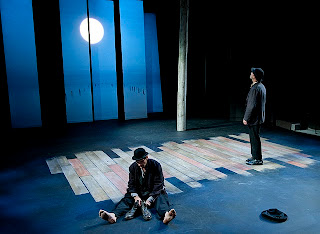I collaborated four artworks with the performance, allocating specific actors and mapping out the exact location of each piece within my space, considering the effect the set will have upon the audience. Other than the visual aesthetic appearance, I thought about using sound art, although dismissed the idea by the outcome. I also reviewed the effects of lighting, hence Parker's piece that projects shadows onto the stage making it eerie and melancholic, further alluding to the sense of an evening country road.
The intention of my performance exhibition is to collaborate performance within the theatre with various contemporary artworks to convey this theme of an ongoing search for meaning and the human struggle. Notions of the passing of time and the waiting for something better are suggested in the performance and in the artworks; both reinforce the ideas of the other.
I found some areas of difficulty in considering where to locate the artworks amongst the set design as I was working with large scale works on a small stage, but worked around any issues that I had by moving Parker's sculpture off of the stage and into the space above, making full use of the area. Another issue I encountered was the labelling of works; obviously I couldn't do this directly on the stage. Instead of labelling the works themselves, I placed the titles/names/descriptions/dates, etc. in a performance programme that would be distributed to the audience members on entering the theatre.
The concept behind the performance exhibition was an endeavour to curate sculptural/installation works in parallel with a live performance experience so the artistic set design is acknowledged. Furthermore, the artworks that act as props on the stage echo the themes that run throughout the continuous play being acted out on the stage. I have made another point of interest by including myself, as the curator/director, to play a character onstage. By allocating the other actors specifically, I was free to choose whomever I wanted in my fantasy cast, so chose the people who I felt would rein-act the characters as I imagine they should be. After looking at all female casts/productions in context etc. I endeavoured to encompass a variety of different actors and actresses.
To improve on my virtual exhibition I would consider the possibility of having the sound of a ticking clock in the background of even artworks upon the balconies (i.e. paintings hanging up so the audience experiences that type of medium before seeing the play). The overall experience of the collaboration of performance/sculpture/installation would be one of interest in any space; I could perhaps take this further by putting the performance in public spaces or in specific meaningful places (i.e. the performance in Sarajevo, etc.).
































